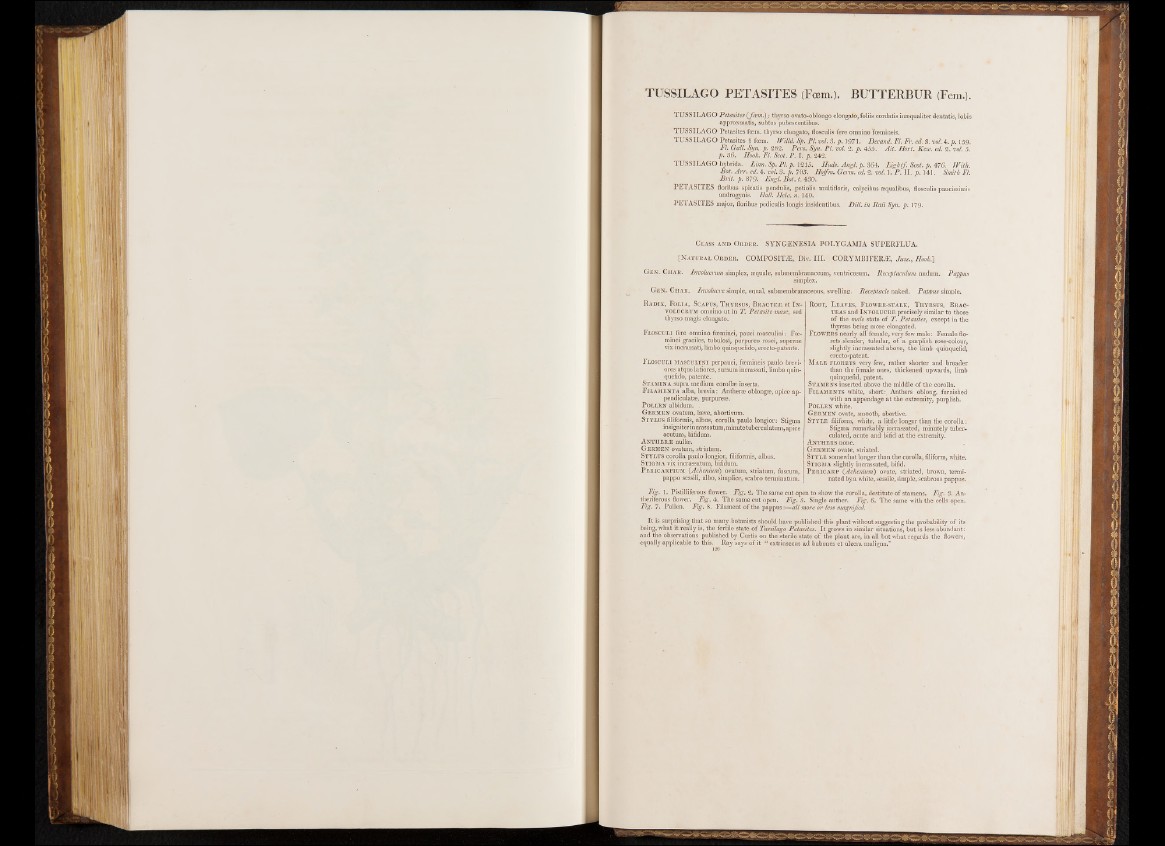
TUSSILAGO PETASITES (Fcem.). BUTTERBUR (Fem.).
TUSSILAGO Petasites (fcem.); thyrso ovato-oblongo elongate, foliis cordatis intequaliter dentatis, lobis
approxmatis, subtus pubescentibus.
TUSSILAGO Petasites foam, thyrso elongato, flosculis fere omnino feemineis.
TUSSILAGO Petasites ? foem. Willd. Sp. PI. ml. 3. p . 1971. Decand. Fl. Fr. ed. 8. ml. 4. p . 159.
FI. Gall. Syn. p . 282. Pers. Syn. PI. ml. 2. p . 455. Ait. Hort. Kew. ed. 2. ml. 5.
p . 36. Hook. Fl. Scot. P . I. p. 242.
TUSSILAGO hybrida. Linn. Sp. PI. p . 1215. Huds. Angl. p . 364. Light/. Scot. p . 476. With.
Bot. Arr. ed. 4. ml. 3. p. 705. Hoffm. Germ. ed. 2. ml. 1. P . II. p . 141. Smith Fl.
Brit. p. 879. Engl. Bot. t. 430.
PETASITES floribus spicatis pendulis, petiolis multifloris, calycibus asqualibus, flosculis paucissimis
androgynis. Hall. Helv. n. 140.
PETASITES major, floribus pediculis longis insidentibus. Dill, in Rail Syn. p. 179.
Class an d Ord e r . SYNGENESIA POLYGAMIA SUPERFLUA.
[Natural Ord er. COMPOSITE, Div. III. CORYMBIFERE, Juss., Hook.]
Ge n . Ch a r . Inmlucrum simplex, tequale, submembranaceum, ventricosum. Receptaculum nudum. Pappus
simplex.
Ge n . Cha r. Involucre simple, equal, submembranaceous, swelling. Receptacle naked. Pappus simple.
Ra d ix, Folia, Scapus, T hyrsus, Bracteie et I n-
volucrum omnino ut in T. Petasite masc, sed
thyrso magis elongato.
F losculi fere omnino foeminei, pauci masculini: Foe-
minei graciles, tubulosi, purpureo rosei, superne
vix incrassati, limbo quinquefido, erecto-patente.
Flosculi masculini perpauci, feemineis paulo brevi- '
ores atque latiores, sursum incrassati, limbo quinquefido,
patente.
Stamin a supra medium corollas inserta.
Filamenta alba, brevia : Antheræ oblongæ, apice ap-
pendiculatas, purpureæ.
P ollen albidum. .
Ge rm en ovatum, losve, abortivum.
Stylus filiformis, albus, corolla paulo longior: Stigma
insigniter incrassatum, minute tuberculatum, apice
acutum, bifidum.
Anth eræ nullas.
G e rm en ovatum, striatum.
Stylus corolla paulo longior, filiformis, albus.
St igma vix incrassatum, bifidum.
P er ica r pium (Achenium) ovatum, sti'iatum, fuscum,
pappo sessili, albo, simplice, scabro terminatum.
Root, L eaves, F lower-stalk, T hyrsus, Brac-
teas and Involucre precisely similar to those
o f the male state o f T. Petasites, except in the
thyrsus being more elongated.
Flowers nearly all female, very few male: Female florets
slender, tubular, of a purplish rose-colour,
slightly incrassated above, the limb quinquefid,
erecto-patent.
Male florets very few, rather shorter and broader
than the female ones, thickened upwards, limb
quinquefid, patent.
Stamens inserted above the middle of the corolla.
Filamen t s white, shorty Anthers oblong, furnished
with an appendage a t the extremity, purplish.
Po l len white.
Ge rm e n ovate, smooth, abortive.
Sty l e filiform, white, a little longer than the corolla:
Stigma remarkably incrassated, minutely tuber-
culated, acute and bifid at the extremity.
An th er s none.
Ge rm en ovate, striated.
Sty l e somewhat longer than the corolla, filiform, white.
St igma slightly incrassated, bifid.
P e r ica r p (Achenium) ovate, striated, brown, terminated
by a white, sessile, simple, scabrous pappus.
Fig. 1. Pistilliferous flower. Fig. 2. The same cut open to show the corolla, destitute of stamens. Fig. 3. An-
theriferous flower. Fig. 4. The same cut open. Fig. 5. Single anther. Fig. 6. The same with the cells open.
Fig. 7. Pollen. Fig. 8. Filament of the pappus:—all more or less magnified.
It is surprising that so many botanists should have published this plant without suggesting the probability of its
being, what it really is, the fertile state of Tussilago Petasites. It grows in similar situations, but is less abundant:
and the observations published by Curtis on the sterile state of the plant are, in all but what regards the flowers,
equally applicable to this. Ray says o f it “ extrinsecus ad bubones et ulcera maligna.”